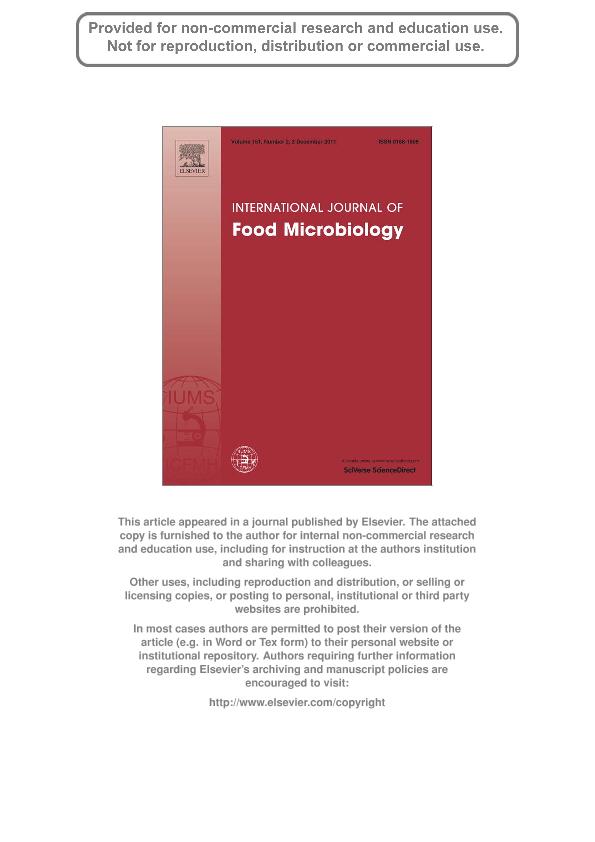Mostrar el registro sencillo del ítem
dc.contributor.author
Oteiza, Juan Martín

dc.contributor.author
Ares, Gastón
dc.contributor.author
Sant'Ana, Anderson S.
dc.contributor.author
Soto, Silvina Andrea

dc.contributor.author
Giannuzzi, Leda

dc.date.available
2020-08-14T13:53:02Z
dc.date.issued
2011-12
dc.identifier.citation
Oteiza, Juan Martín; Ares, Gastón; Sant'Ana, Anderson S.; Soto, Silvina Andrea; Giannuzzi, Leda; Use of a multivariate approach to assess the incidence of Alicyclobacillus spp. in concentrate fruit juices marketed in Argentina: Results of a 14-year survey; Elsevier Science; International Journal of Food Microbiology; 151; 2; 12-2011; 229-234
dc.identifier.issn
0168-1605
dc.identifier.uri
http://hdl.handle.net/11336/111736
dc.description.abstract
The purpose of this study was to determine the incidence of Alicyclobacillus spp. in fruit/vegetable juices (concentrated pulps and clarified and non-clarified juices) marketed in Argentina between 1996 and 2009. The presence of Alicyclobacillus was determined in a total of 8556 samples of fruit and vegetable juices (apple, pear, grape, peach, blend of juices, tangerine, pineapple, orange, mango, plum, guava, apricot, lemon, banana, kiwi, carrot, strawberry, grapefruit, and beetroot) collected in seven Argentinean provinces. Multiple factor analysis (MFA) was carried out on a data matrix that contained the percentage of positive samples, type of juice, raw material and production year. Except for kiwi and orange, Alicyclobacillus was found in juices from all the evaluated raw materials. The highest percentage of positive samples was found for beetroot, strawberry, banana, peach, mango, carrot and plum juices. The percentage of positive samples for these juices ranged from 100% to 24%. Furthermore, the application of multivariate techniques provided an insight on the relationship between the incidence of Alicyclobacillus and production variables. This approach enabled the identification of the most relevant variables that increased the percentage of positive samples among the juices, which could help in developing strategies to avoid the incidence of this bacterium. By means of hierarchical cluster analysis seven groups (clusters) of juices which showed different percentages of positive samples for Alicyclobacillus spp. were identified. This analysis showed that pineapple, peach, strawberry, mango and beetroot juices had higher rates of positivity for Alicyclobacillus than the rest of the evaluated juices. MFA analysis also showed that some clear relationships could be highlighted between the percentage of samples positive for Alicyclobacillus and five types of fruit juices (strawberry, beetroot, grapefruit, pineapple and mango). It was observed that a large proportion of juices produced in 2000, 2005 and 2008 were located in clusters with higher incidence of Alicyclobacillus spp., whereas a larger proportion of clarified concentrate juice and concentrate pulp samples showed higher probability of incidence of Alicyclobacillus in these products. Data presented in this study brings a contribution to the ecology of Alicyclobacillus in fruit/vegetable juices marketed in Argentina. This information would be useful to enhance the microbiological stability of fruit juices regarding the presence of Alicyclobacillus spp.
dc.format
application/pdf
dc.language.iso
eng
dc.publisher
Elsevier Science

dc.rights
info:eu-repo/semantics/openAccess
dc.rights.uri
https://creativecommons.org/licenses/by-nc-sa/2.5/ar/
dc.subject
Alicyclobacillus
dc.subject
Fruit juices
dc.subject
Spoilage
dc.subject
Multivariate statistics
dc.subject
Multivariate statistics
dc.subject.classification
Alimentos y Bebidas

dc.subject.classification
Otras Ingenierías y Tecnologías

dc.subject.classification
INGENIERÍAS Y TECNOLOGÍAS

dc.title
Use of a multivariate approach to assess the incidence of Alicyclobacillus spp. in concentrate fruit juices marketed in Argentina: Results of a 14-year survey
dc.type
info:eu-repo/semantics/article
dc.type
info:ar-repo/semantics/artículo
dc.type
info:eu-repo/semantics/publishedVersion
dc.date.updated
2020-07-01T16:14:11Z
dc.identifier.eissn
1879-3460
dc.journal.volume
151
dc.journal.number
2
dc.journal.pagination
229-234
dc.journal.pais
Países Bajos

dc.journal.ciudad
Amsterdam
dc.description.fil
Fil: Oteiza, Juan Martín. Provincia de Buenos Aires. Gobernación. Comisión de Investigaciones Científicas. Centro de Investigación y Desarrollo en Criotecnología de Alimentos. Consejo Nacional de Investigaciones Científicas y Técnicas. Centro Científico Tecnológico Conicet - La Plata. Centro de Investigación y Desarrollo en Criotecnología de Alimentos. Universidad Nacional de La Plata. Facultad de Ciencias Exactas. Centro de Investigación y Desarrollo en Criotecnología de Alimentos; Argentina
dc.description.fil
Fil: Ares, Gastón. Universidad de la República; Uruguay
dc.description.fil
Fil: Sant'Ana, Anderson S.. Universidade de Sao Paulo; Brasil
dc.description.fil
Fil: Soto, Silvina Andrea. Centro de Investigación y Asistencia Técnica a la Industria; Argentina
dc.description.fil
Fil: Giannuzzi, Leda. Provincia de Buenos Aires. Gobernación. Comisión de Investigaciones Científicas. Centro de Investigación y Desarrollo en Criotecnología de Alimentos. Consejo Nacional de Investigaciones Científicas y Técnicas. Centro Científico Tecnológico Conicet - La Plata. Centro de Investigación y Desarrollo en Criotecnología de Alimentos. Universidad Nacional de La Plata. Facultad de Ciencias Exactas. Centro de Investigación y Desarrollo en Criotecnología de Alimentos; Argentina
dc.journal.title
International Journal of Food Microbiology

dc.relation.alternativeid
info:eu-repo/semantics/altIdentifier/url/https://tinyurl.com/y49a7o3n
dc.relation.alternativeid
info:eu-repo/semantics/altIdentifier/doi/https://www.sciencedirect.com/science/article/abs/pii/S0168160511005228
Archivos asociados
